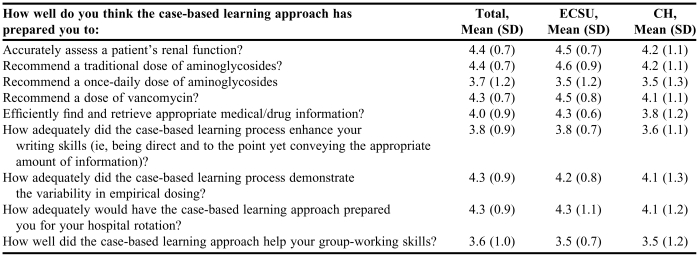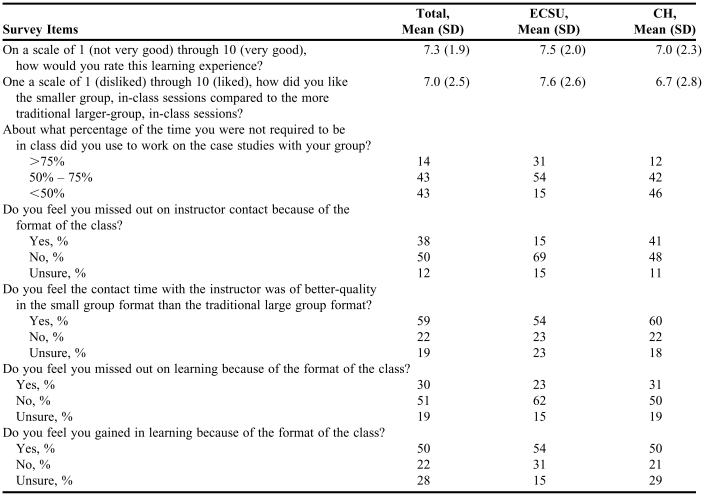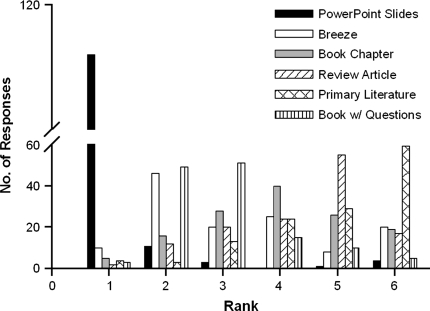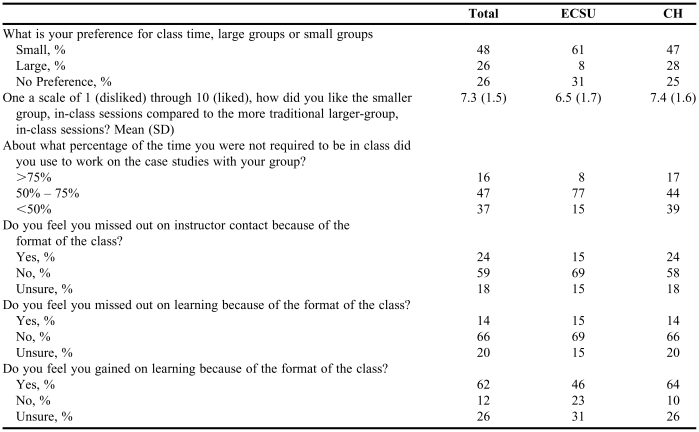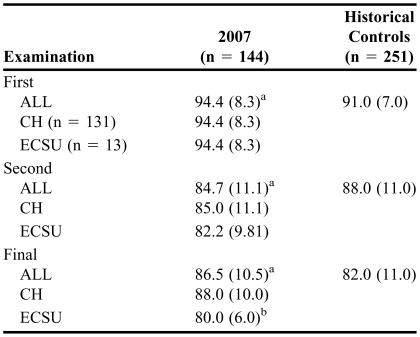Abstract
Objective
To assess the redesign of a clinical pharmacokinetics course that incorporated case-based learning to enhance group interaction and individual participation.
Design
The clinical pharmacokinetics course was divided into 3 sections based on content. Section 1 utilized case-based learning with small in-class groups; section 2 used a more traditional style of teaching, and section 3 was taught with case-based learning but using large in-class groups. The case-based learning approach was assessed using examination scores and attitudinal surveys.
Assessment
Students enjoyed the applied format of case-based learning. Examination scores were higher when case-based learning was used than in historical controls.
Conclusions
Case-based learning allowed class-time to be used for higher levels of learning and assessment instead of the more typical content delivery.
Keywords: case-based learning, pharmacokinetics, pedagogy
INTRODUCTION
According to Bloom's cognitive taxonomy, higher orders of learning, above those of knowledge and comprehension, are crucial for clinical training in any health science. Therefore, application of principles is a key component to deep-learning and is sometimes lost in the more basic science side of a pharmacy curriculum, such as in pharmacokinetics. Often the application part of pharmacokinetic principles occurs during the student's experiential education. While this is the goal of experiential education, some students may enter their experiential education having foundational knowledge but not being fully aware of its utility in clinical practice. Providing students with more opportunities to apply their knowledge during their didactic training may accelerate or expand their learning in the experiential years. The challenge is using classroom time not for content delivery but for discussion of the application of concepts using real life examples.
Case-based learning (CBL) is an active-learning strategy, much like problem-based learning (PBL), involving small groups in which the group focuses on solving a presented problem. Srinivasan et al1 points out that unlike problem-based learning, case-based learning requires some advanced preparation by the students and provides more structure for the learner. Thus, this structured method may be better used to prepare younger learners for unstructured learning activities like problem-based learning (PBL) or in becoming better self-learners. In addition, proponents of CBL argue that this method helps focus the learners on the key points of a clinical case, and encourages a structured approach to clinical problem-solving while allowing facilitators to correct any incorrect assumptions of the learner, which does not always happen in PBL. These 2 approaches have several advantages over traditional lectures. The first advantage is that learners are more actively engaged in their learning compared to lecture methods where students may be passive and their attention may wane. The second advantage is that in-class activities are focused on application, problem-solving, and communication (ie, higher levels of learning), whereas a traditional lecture is focused on content delivery and not set up for higher levels of learning. The final advantage is that the in-class format allows for feedback on the case studies and opportunities to discuss issues with experts in the field, whereas during a lecture there is little feedback on the student's comprehension.
The purpose of this manuscript is to assess and discuss the incorporation of CBL into select areas of a clinical pharmacokinetics course. The overall goals of this transformation are to improve learning, especially in the area of application, and to improve student-instructor interaction.
DESIGN
Pharmacokinetics instruction in the School of Pharmacy at The University of North Carolina at Chapel Hill consists of 2 courses starting in the fall of the second-professional year and continuing through the spring of their second-professional year. The PHCY 414 occurs in the spring semester of the second-professional year and serves as the clinical portion of pharmacokinetics in the professional pharmacy curriculum. The enrollment in the 2007 academic year was 144 students, with 13 students at the distant site campus (Elizabeth City State University) and 131 students at the Chapel Hill campus. All classes are taught using synchronous video teleconferencing. The control class (2005 and 2006), which was not taught by video teleconferencing, had an enrollment of 251 students. Based on admission profiles from the historical control (2005 and 2006) and 2007 cohorts, these classes were equivalent in composition for sex (33% male vs 36% male), age (19-45 years vs 19-56 years), number of students with previous degrees (approximately 65%), average PCAT score (392 vs 400), and average entering grade point average (3.5 vs 3.5).
PHCY 414 is a 3-credit course that historically met 3 times a week for 50 minutes per class. For the 2007 academic year, the course content and its delivery was divided into 3 sections. Section one (S1) was approximately 4 weeks long and focused on basics of therapeutic drug monitoring and renal-based dosing (ie, creatinine clearance, renal dysfunction, aminoglycosides, vanocmycin, and dialysis). This section was taught almost exclusively using case-based learning, except the first 2 classes which reviewed patient assessment, making recommendations and note writing from a pharmacokinetic perspective. All other sessions were conducted as described below.
Students were assigned to groups of 4 to 5, based on their prior exposure to drugs covered during the course that occurred in their early hospital experience the summer between their first- and second-professional years. This experience was determined using a pre-course survey. Groups were assigned 1 out of 6 case studies to complete during the week as a group and had to attend class once a week for 50 minutes (instead of the standard 50 minute class 3 times a week) to discuss their assigned cases. Students were also encouraged to work on the other cases that other groups were assigned. Groups did not have to attend the other two 50-minute sessions during the week, but instead were encouraged to use that “free” time to work with their group on these cases.
At the beginning of each assigned class session, students had to turn in a written report of their work. This report included background information (equations and calculations, references) used to develop their recommendation and a pharmacokinetic consult note. During the class, individuals from each group either volunteered or were called upon to discuss their cases. The remainder of the students were allowed to ask questions of the group presenting the case. Three to four of the assigned cases were discussed in each class session. These discussions were led by a content expert whose main responsibility during each class session was to highlight and further explain important points and issues.
In order to prepare for each case, students were assigned specific readings. These included textbook readings, journal articles, and/or PowerPoint slides with notes. Students could also use other materials and references. In order to hold individuals accountable for their group cases, students were required to complete an individual quiz that was related to readings and cases prior to attending their assigned class session; quizzes were administered and managed through Blackboard.
Section 2 of the course used the traditional format used in previous years. This section focused more on hepatically cleared drugs such as anticonvulsants, antiretrovirals, immunosuppressants, antiarrythmics, and antineoplastics. During this section, all students attended class 3 times a week for 50 minutes and class format ranged from PowerPoint lectures to Socratic discussions, depending on the style of the individual instructors. Students were only given required readings for specific topics prior to class. Any cases utilized during this section were not given out prior to class. There were no group assignments during this section.
The third and final section of the course included various topics and different learning approaches. Anticoagulation was taught by traditional lecture, antidepressants and the Top 300 drugs were taught in game format,2 and lithium was taught using case-studies, which was consistent with previous years. Both the games and the case studies required preparation by students through reading assignments. The case-based learning approach was used for the Special Populations section (ie, pregnancy, elderly, obesity, and neonates/children). All groups worked on the same case for a week in lieu of class-time; this case included all the special populations and was written in a story format. As in section 1, students completed an online quiz to ensure individual accountability for the content. The following week, the entire class submitted their written responses and then discussed the cases; this discussion was facilitated by a content expert. The reason for using this format in the final section (with all the students attending class) versus a small group approach was because the discussions were led by off-campus based faculty members who could only attend class once a week.
ASSESSMENT
The total points a student could earn in the course for the entire semester was 600 points, with approximately half based on individual work and half based on group work. The individual work included 3 quizzes based on basic content covered in the cases to ensure each individual was prepared for their cases. Two of the quizzes occurred in section 1 and one quiz occurred in section 3 and each was worth 10 points. There was an individual case during section 2 consistent with previous years and it was also worth 10 points.
There were 3 examinations, one at the end of each section. The first examination was worth 90 points, the second examination was worth 190 points, and the final examination was worth 100 points; the final examination was cumulative in the sense that drugs previously discussed in class were used in the context of special populations. Each section was worth 200 points.
Section 1 included 20 points in individual quizzes, 90 points in an individual examination, and 90 points for 3 case studies. Section 2 included 190 points for an individual examination and 10 points for the individual case study. Section 3 included 100 points for individual examination, 10 points for individual quizzes, and 90 points for the case study, with 60 points allocated for the case and 30 points allocated for peer evaluation of participation. The first examination was case-based, similar to the cases completed during that section of material. The second examination was similar in format to that used in previous years, with a combination of short answer, multiple-choice questions, and open-ended problems. The final examination included case-based, multiple-choice questions and extended matching, which was consistent with previous years with the exception of a greater amount of questions in case format.
Attitudinal survey instruments were administered at the end of the first and third examinations and included preferences for case-based learning, difficulty of cases, overall feelings of learning, and competency in the topic areas. The final survey instrument also included questions related to students' perception of their role as learners, their role during group work, and the role of instructors. The format of the survey instruments was a combination of 5-point Likert scale (eg, strongly agree to strongly disagree) items, open-scaled questions (eg, on a scale of 1 to 10 with 10 being the best), and multiple- choice questions.
Examinations scores from the 2007 academic year were compared to the historical controls using a Mann-Whitney test with p < 0.05 set as statistically significant. A nonparametric test was used because of the left-hand skew of the grades and failure of the Kolmogorov-Smirnov normality test in determining normality in grade distribution. A chi-square test was used to compare results between the 2 campuses for categorical data. The final survey questions on perception of students' and instructors' roles were used to explain overall feelings about the CBL approach or grades utilizing multiple linear regression.
Table 1 and Table 2 summarize the survey results following section 1 and show that there were no significant differences in student perceptions/attitudes between the 2 campuses. In general, students felt only having class once a week was of better quality and did not cause them to feel they missed out on instruction (Table 2). The students did rate the case-based experience high (7.3 out of 10, Table 2). Approximately 57% of the students used at least half of the free class time to work on the cases (Table 2). Students indicated that PowerPoint slides with notes posted online were their preferred resources followed by readings with guided questions and Breeze (Adobe Systems, San Jose, Calif) presentations (Figure 1). (Breeze is a web collaboration tool that allows participants at different locations to communicate visually, verbally and allows sharing of documents.) Students felt less prepared (p < 0.05, one-way ANOVA) on information concerning once-daily dosing of aminoglycosides compared to the other content portions.
Table 1.
Pharmacy Students' Responses Regarding a Case-based Learning Course on Renally Dosed Drugs (N = 139)
Abbreviations: CH = Chapel Hill Campus (n = 126; 96.1% response rate) and ECSU = Elizabeth City State campus (n = 13; 100% response rate) Scores are based on a scale of 1 to 5 on which 5 = very well and 1 = very poorly. Data presented as mean and standard deviation
Table 2.
Pharmacy Students' Responses Regarding a Case-based Learning Course on Renally Dosed Drugs (N = 139)
CH = Chapel Hill Campus (n = 126, 96.1% response rate) and ECSU = Elizabeth City State campus (n = 13, 100% response rate)
Figure 1.
Survey questions pertaining to the students' preference for resources material. 1 = strong preference, 6 = weak preference. (n = X, % response rate).
At the end of section 3, students felt they understood the basics of treating special populations (Table 3). Students did seem to prefer small-group in-class sessions (48% of responders) compared to large-group in-class sections (26%). This difference was more apparent among students at the distance site, with 61% favoring the small-group format and 8% favoring the large-group format, compared to the Chapel Hill site, where 47% favored the small-group format and 28% favored the large-group format (Table 4). Most students felt they did not miss out on instructor contact because of the format and gained on learning. There were significant differences in the proportion of responses between section 1 and section 3 when students were asked if they missed out on instructor contact (p < 0.05, X2) or missed out on learning (p < 0.005, X2) because of the format; in both cases the “yes” response was decreased in section 3. When asked whether they gained on learning because of the format, there was no significant difference in the proportion of observations between section 1 and section 3 (p = 0.058, X2) with the “yes” response being 50% and 62% for section 1 and section 3, respectively. When asked if the CBL format improved writing skills (ie, the ability to summarize information succinctly), students felt it did not have a strong positive effect.
Table 3.
Pharmacy Students' Responses Regarding a Case-based Learning Course on Special Populations (n = 135)
Abbreviations: CH = Chapel Hill campus (n = 122, 93% response rate) and ECSU = Elizabeth City State campus (n = 13, 100% response rate)
Scores are based on a scale of 1 to 5 on which 5 = very well and 1 = very poorly
Table 4.
Pharmacy Students' Responses Regarding a Case-based Learning Course on Special Populations (N = 139)
Abbreviations: Chapel Hill Campus (n = 122, 93% response rate) and ECSU = Elizabeth City State campus (n = 13, 100% response rate)
When comparing examination scores to historical controls from previous years, scores on examinations 1 and 3, which corresponded to sections of the course where case-based learning was used, were significantly higher than historical controls. Scores on examination 2, which covered information presented using the standard class format used in previous years were significantly lower than historical controls (Table 5). A significant difference between the scores of students at different campuses was only seen on final examination scores, with students at the Chapel Hill site performing better.
Table 5.
Comparison of Examination Scores of Pharmacy Students in a Case-Based Learning Course Compared to Historical Controls
Abbreviations: CH = Chapel Hill campus; ECSU = Elizabeth City State University campus
ap < 0.005 compared to Historical Control (Mann-Whitney test)
bp < 0.01 compared to Chapel Hill (CH) campus (Mann-Whitney test)
Examination 1 followed case-based learning; Examination 2 followed similar format to the historical controls (ie, traditional classroom instruction); Examination 3 following in part, case-based learning. Data presented as median and interquartile range.
Questions were asked of the students related to their feelings and perceptions about various aspects of learning in attempts to relate attitudes about learning to the overall impact of the CBL format. Students tended to favor the idea that a correct answer was dependent on the context of the situation (88% agreeing; n = 125) and that they tried to think independently and analyze the situation (68% agreeing; n = 97). However, approximately 40% (n = 61) of the students felt the answers to the case studies were known and could be found in resources. Students also felt strongly that their group members had a role in the learning process and were supportive of learning efforts (78% agreeing; n = 111) and wanted their group mates to use evidence or logic to present and back up their remarks (85% agreeing; n = 120). Eighty-eight percent of the students (n = 125) surveyed agreed that they wanted instructors to show them how to use intellect to approach and solve problems. Of the 11 questions asked, there was no significant correlation between the questions and grades or the questions and overall rating of the CBL experience.
DISCUSSION
Active learning can be defined as anything that involves students in doing things and thinking about the things they are doing.3 The passive learning of material, for example when a student listens to a lecture or reads a chapter in a book or article, offers very little to the student unless more is added to the learning experience.4 When students perform actions similar to what they would encounter in future experiences, they will learn the skills more proficiently. Case-based learning, where students learn to evaluate a patient and recommend dosing, is a relevant and important educational experience because they are “doing” what they would be responsible for in the future. In the approach taken here, students learned the material on their own but then applied the information in a meaningful way in solving cases. Students then arrived at class ready to discuss and reflect on what they were learning. During both the out-of-class time and in-class time, students learned from and interacted with their peers while discussing the cases. This interaction not only facilitated learning but also enhanced communication skills.
To increase the active-learning component and application of material, the CBL approach was used in 2 different formats: the first format used small groups (4-5 members) to complete cases and students came to class in medium-sized groups (40-50); the second approach used the same small-group format for case-study completion but all students attended class. The students appeared to favor the smaller in-class format, probably stemming from the more personal interaction this format required. However, most students also enjoyed the case-based format because it was application-based and because they had class time off to complete assignments. Students commented that they would have preferred 1 day of lecture a week to introduce content followed by small-group activities. While this appeared a popular recommendation, the introductory material lecture would in part defeat the purpose of the self-directed learning aspect of CBL. In addition, having 2 days of small-group activities would yield larger groups (2 groups of approximately 75 versus 3 groups of 50) unless more class days were added to each week, which would be a large logistical issue. Although most groups did not encounter any problems, a few groups experienced individuals neglecting their responsibilities by not doing their part within the group. This issue was addressed through individual quizzes and examinations. In addition, during the CBL approach in section 3, at the end of the semester, a peer evaluation process was created to ensure either equal participation or to penalize those who did not participate adequately. In most cases this resolved the issue of individuals not doing their part. The students also recommended that students be allowed to form their own groups and select their own members. When designing the exercise, the instructors felt balancing groups based on students' first-year clinical experience would be beneficial and thus did not allow students to self-select their groups. Allowing students to self-select their groups tends to lead to “group think” because individuals tend to select individuals like themselves. Also, the goal of having students work in groups is to help individuals learn to work with individuals of varying backgrounds, experiences, and opinions. Students also tend to select group members based on similar work/school schedules. However, since students were only required to come to class once a week in order to have 2 open hours to meet with their groups, coordinating schedules was not a major obstacle.
One reason for implementing case-based learning was to better engage students at the distance site. In most aspects, the distance site was equivalent to the local campus site. In a traditional lecture format, the students' at the distance site may feel less engaged, in part because of the large difference in number of students at the site. Making class sizes smaller can improve student interaction at both campuses. In addition, since the basic content was removed from the class the restriction of an instructor being a “good lecturer,” able to engage a large class and distance site is removed because the basic content is now the responsibility of the student to learn on their own.
SUMMARY
Cased-based learning was implemented in an applied pharmacokinetics course to focus on applying pharmacokinetic concepts, pursuing higher levels of learning, and improving student participation at a distant site. The majority of students enjoyed the format because it focused on application; some students, however, did not enjoy the ‘learning on their own’ aspect of the format. This format will be continued and further developed for the course.
REFERENCES
- 1.Srinivasan M, Wilkes M, et al. Comparing problem-based learning with case-based learning: effects of a major curricular shift at two institutions. Acad Med. 2007;82:74–82. doi: 10.1097/01.ACM.0000249963.93776.aa. [DOI] [PubMed] [Google Scholar]
- 2.Persky AM, Stegall-Zanation J, et al. Students perceptions of the incorporation of games into classroom instruction for basic and clinical pharmacokinetics. Am J Pharm Educ. 2007;71 doi: 10.5688/aj710221. Article 21. [DOI] [PMC free article] [PubMed] [Google Scholar]
- 3.Bonwell CC, Eison JA. Active Learning: Creating Excitement in the Classroom. Washington, DC: George Washington University; 1991. [Google Scholar]
- 4.Fink LD. Creating Significant Learning Experiences: An Integrated Approach to Designing College Courses. 1st ed. San Francisco, Calif: Jossey-Bass; 2003. [Google Scholar]



